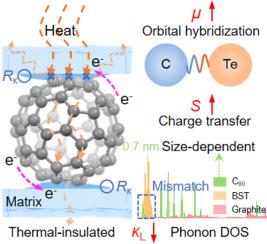Constructing high-performance bulk thermoelectric composites by incorporating uniformly dispersed fullerene sub-nanoclusters
IF 8.3
1区 材料科学
Q1 MATERIALS SCIENCE, MULTIDISCIPLINARY
引用次数: 0
Abstract
Sub-nanomaterials possess unprecedented size-dependent properties compared to conventional nanomaterials, which endow them with great potential in catalysis, biomedicine, sensors, and so on. However, their applications in thermoelectrics are unknown due to poor thermal stability and low yields. Herein, we construct a series of thermoelectric composites by incorporating highly thermally stable and commercial fullerene sub-nanoclusters (C60 or C70). We find that sub-nanoclusters as the second phase can conduce to optimized carrier concentration through charge transfer at interfaces while the carrier mobility is significantly enhanced due to atom orbital hybridization and size-dependent electrical scattering mechanism. Furthermore, the ultra-low thermal conductivity of C60 due to its distorted chemical bonding and sub-nanometer pore, and the interfacial thermal resistance greatly suppress the phonon transport. Consequently, the 0.15 mol.% C60/Bi0.4Sb1.6Te3 realizes an ultra-high ZT of ∼1.6 at 373 K, an excellent thermoelectric conversion efficiency of ∼7.4 %, and a huge cooling performance of ∼73 K. This work demonstrates the application of sub-nanomaterials in thermoelectrics and may shed light on other fields such as electronic devices, thermal management, and fullerene chemistry.


通过加入均匀分散的富勒烯亚纳米团簇构建高性能块状热电复合材料
与传统纳米材料相比,亚纳米材料具有前所未有的尺寸特性,这赋予了它们在催化、生物医学、传感器等领域的巨大潜力。然而,由于热稳定性差和产量低,它们在热电领域的应用尚不为人知。在本文中,我们通过加入高热稳定性的商用富勒烯亚纳米团簇(C60 或 C70),构建了一系列热电复合材料。我们发现,亚纳米团簇作为第二相,可通过界面上的电荷转移优化载流子浓度,同时由于原子轨道杂化和尺寸依赖性电散射机制,载流子迁移率显著提高。此外,C60 因其扭曲的化学键和亚纳米孔隙而具有超低的热导率,而界面热阻则极大地抑制了声子传输。因此,0.15 mol% C60/Bi0.4Sb1.6Te3 在 373 K 时实现了 ∼1.6 的超高 ZT、∼7.4% 的优异热电转换效率和∼73 K 的巨大冷却性能。这项工作展示了亚纳米材料在热电领域的应用,并可能为电子器件、热管理和富勒烯化学等其他领域带来启示。
本文章由计算机程序翻译,如有差异,请以英文原文为准。
求助全文
约1分钟内获得全文
求助全文
来源期刊

Acta Materialia
工程技术-材料科学:综合
CiteScore
16.10
自引率
8.50%
发文量
801
审稿时长
53 days
期刊介绍:
Acta Materialia serves as a platform for publishing full-length, original papers and commissioned overviews that contribute to a profound understanding of the correlation between the processing, structure, and properties of inorganic materials. The journal seeks papers with high impact potential or those that significantly propel the field forward. The scope includes the atomic and molecular arrangements, chemical and electronic structures, and microstructure of materials, focusing on their mechanical or functional behavior across all length scales, including nanostructures.
 求助内容:
求助内容: 应助结果提醒方式:
应助结果提醒方式:


